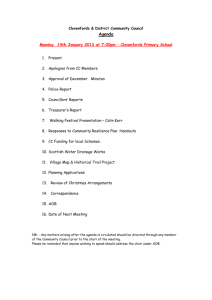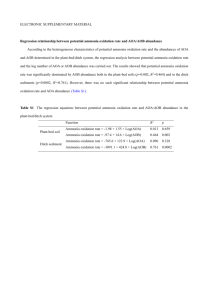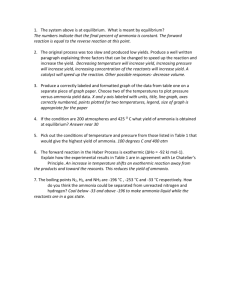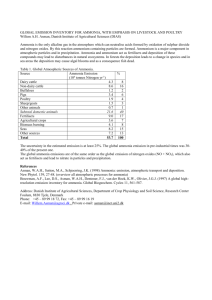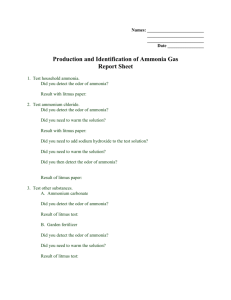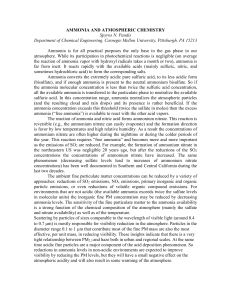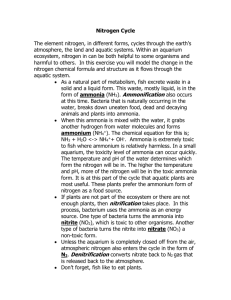Supporting Information
advertisement
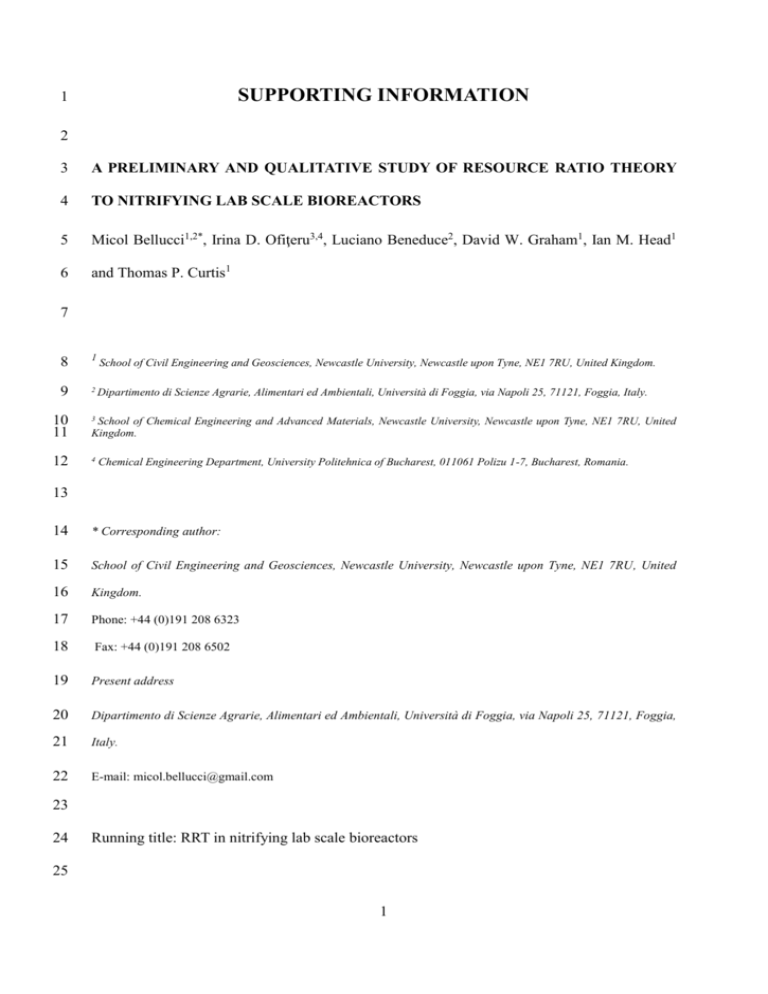
SUPPORTING INFORMATION 1 2 3 A PRELIMINARY AND QUALITATIVE STUDY OF RESOURCE RATIO THEORY 4 TO NITRIFYING LAB SCALE BIOREACTORS 5 Micol Bellucci1,2*, Irina D. Ofiţeru3,4, Luciano Beneduce2, David W. Graham1, Ian M. Head1 6 and Thomas P. Curtis1 7 8 1 9 2 Dipartimento 10 11 3 12 4 School of Civil Engineering and Geosciences, Newcastle University, Newcastle upon Tyne, NE1 7RU, United Kingdom. di Scienze Agrarie, Alimentari ed Ambientali, Università di Foggia, via Napoli 25, 71121, Foggia, Italy. School of Chemical Engineering and Advanced Materials, Newcastle University, Newcastle upon Tyne, NE1 7RU, United Kingdom. Chemical Engineering Department, University Politehnica of Bucharest, 011061 Polizu 1-7, Bucharest, Romania. 13 14 * Corresponding author: 15 School of Civil Engineering and Geosciences, Newcastle University, Newcastle upon Tyne, NE1 7RU, United 16 Kingdom. 17 Phone: +44 (0)191 208 6323 18 Fax: +44 (0)191 208 6502 19 Present address 20 Dipartimento di Scienze Agrarie, Alimentari ed Ambientali, Università di Foggia, via Napoli 25, 71121, Foggia, 21 Italy. 22 E-mail: micol.bellucci@gmail.com 23 24 Running title: RRT in nitrifying lab scale bioreactors 25 1 26 Resource Ratio Theory Model Description 27 Background: RRT states that the quantity of the growth limiting resources available in a 28 heterogeneous environment determines the species richness of a biological community 29 (Tilman, 1982). In homogeneous habitats, the competition for two growth limiting resources 30 (R1 and R2) among more than one species is described in Figure S1. In this plot the Zero Net 31 Growth Isoclines, or ZNGI, represent the amount of the two growth limiting resources that 32 must be available in the system such that growth is equal to the mortality rate. Different 33 species have different ZNGIs. In order to maintain an equilibrium population, the resource 34 consumption rate must balance the resource supply rate. This equilibrium point is plotted as 35 consumption vectors (Cv). The Cv, along with the ZNGIs, defines different regions 36 (homogenous habitats) in which either two species coexist or one of the two becomes 37 dominant. To apply those predictions to heterogeneous habitats, microhabitats are included in 38 the plots. Those are graphically expressed as circles (Figure S1) given by the 0.99 probability 39 contour of a bivariate distribution calculated by the mean and variance of the two resources in 40 each habitat. The species richness and composition in each microhabitat is inferred by 41 evaluating the diversity of the differing homogeneous regions overlapping the circles. 42 43 Here we simulated an AOB community of 23 species to assess competition for oxygen and 44 ammonia as casted for the RRT model. Tilman’s model was recast by making the following 45 assumptions: 46 The activated sludge floc is a heterogeneous environment, and offers more than one 47 potential microhabitat, as ammonia and oxygen vary as a function of depth in 48 activated sludge flocs (Li and Bishop, 2004). 49 50 23 AOB species (total number of OTUs retrieved in the AOB 16S rRNA gene clone libraries) compete for oxygen and ammonia. 2 51 In the resource space framework space, the ammonia concentration, resource1, ranges 52 between 0 and 280 mg/l (the latter being the maximum ammonia concentration in the 53 inlet), whereas the oxygen supplied, resources2, varies between 0 and 21%. The 54 amount of the two resources is normalized in order to have a range between 0-1. 55 The ZNGIs and the consumption vectors are chosen randomly as they depend on the 56 species’ growth and mortality rate, as well as on the affinities for the two resources. In 57 this experimental set it was not possible to define these parameters for each species. 58 Consequently, the ZNGIs and consumption vectors were placed in the framework as 59 follows: 60 1) An incline line passing through the minimum amount of the two resources 61 supplied to the bioreactors (24 mg/l of ammonia and 2 % of oxygen) was defined 62 in the simulation space (grey dash line in Figure S1). We have assumed that no 63 species could survive under those values. 64 2) On the incline line we have randomly defined 23 points, from which the ZNGIs 65 had been originated. 66 3) The point where the ZNGIs cross (stars in Figure S1) is defined as a two species 67 equilibrium point, in which the two species coexist. Consumption vectors of the 68 two species were derived with a random slope from each crossing point. 69 The microhabitats were represented as circles (500) and placed randomly in the 70 resource space by generating their centre, which corresponds to the mean values of the 71 two resources. 72 The size of the microhabitat (the radius of the circle) was defined (i) by inferring the 73 diffusion and consumption of a given resource and (ii) by considering the minimum 74 resource variance suitable to comprise all the potential species. 75 3 76 For each given radius 50 replicates were generated. The averages of the species richness and 77 the relative standard deviations were then plotted against the resource gradient (as (resource1 78 + resource2)/2) and compared with the experimental data. 79 80 Calculating the circle radius using diffusion and consumption of resources: The 81 gradient of the resources (i.e. ammonia or oxygen) through a fixed size floc was calculated 82 using a diffusion-consumption dynamic mass balance equation (Levenspiel, 1999): 83 Si 2S Di 2i - ri t x (1) 84 where S is the ith resource concentration, D is the diffusion coefficient for the resource i, r is 85 the consumption rate, t represents the time, and x is the floc depth. We assumed that the floc 86 has a diameter of 50 μm (radius equal 25 μm ) (Zartarian et al., 1997; Zhang et al., 1997). The 87 consumption rate r was calculated using Monod kinetics for each of the two substrates. 88 To calculate the diffusion and consumption of the resources, equation (1) was transformed in 89 a dimensionless form as follows: 90 Si 2 Si Si Di - max X YSi / X 2 t K i Si x 91 by considering 92 activated sludge floc; 93 floc (mg/l) (maximum concentration of ammonia and oxygen in the bulk solution), 94 The equation (2) can thus be rearranged as: 95 i Di t 2i X - max t YSi / X 2 2 Sbulk ,i R (2) t x , where t is the SRT (3 day); , where R is the radius of the t R Si Sbulk ,i , where Sbulk is the concentration outside the activated sludge i Ki Sbulk , i 96 having the initial and boundary conditions: 4 (3) i 97 i 0, , =0 finite substrate decrease 1, , 1 no external resistance for substrate i 0, 0 1, i 0 no initial substrate in the floc (4) 98 99 The parameters used to define the variation of the oxygen and ammonia through the activated 100 sludge floc are reported in Table S1. To delineate the circles in the resource space framework, 101 we assumed that the variation () of the two resources within the activated sludge floc is the 102 same (. The 0.99 probability contour of the bivariate distribution is given by 103 multiplying for 2.58 (Sokal and Rohlf, 1995). 104 105 Radius of the circle defined as minimum resource variance comprising all the 106 potential species: Theoretically, there should be a microhabitat in which all the species 107 coexist. This microhabitat can be defined as a circle that encompasses all the species. In order 108 to define the radius of this circle, we outlined the circle that circumscribes the corner of the 109 first and the last ZNGI present in the framework, which is the only region in the simulation 110 space where all the species coexist. 111 112 Determination of free ammonia and free nitrous acid 113 Free ammonia (FA) and free nitrous acid (FNA) in the bioreactors were calculated in function 114 of the experimental values of total ammonia and nitrite concentrations, pH and temperature 115 using the following equation described by Anthonisen and colleagues (Anthonisen et al., 116 1976): 117 FA as NH3 ( mg⁄L) = 14 × 17 total ammonia as N (mg⁄L) ×10pH , (Kb ⁄Kw )+ 10pH 5 118 in which K b ⁄K w = e(6334⁄(273+T(°C)) 119 46 NO2 − −N as N (mg⁄L) 120 FNA as HNO2 ( mg⁄L) = 14 × 121 in which K a = e(−2300⁄(273+T(°C)) Ka + 10pH , 122 123 where: 124 Kb = ionization constant of the ammonia equilibrium equation 125 Kw = ionization constant of water 126 Ka = ionization constant of the nitrous acid equilibrium equation 127 T= temperature (°C) 128 129 The results are summarized in Figure S2. 130 131 Rarefaction curves 132 Rarefaction curves based on the OTUs observed in the AOB clone libraries were constructed 133 and reported in Figure S3. 6 134 REFERENCES 135 136 137 138 139 140 141 142 143 144 145 146 147 148 149 150 151 152 153 154 155 156 157 158 159 160 161 162 163 Anthonisen AC, Loehr RC, Prakasam TBS, Srinath EG (1976). Inhibition of nitrification by ammonia and nitrous acid. Journal of the Water Pollution Control Federation 48: 835-852. Levenspiel O (1999). Chemical Reaction Engineering, Third edition edn. Li B, Bishop PL (2004). Micro-profiles of activated sludge floc determined using microelectrodes. Water Research 38: 1248-1258. Metcalf, Eddy (2003). Wastewater Engineering: Treatment and Reuse, 4th edition edn. The McGraw-Hill Companies, Inc.: New York. Rittmann BE, McCarty PL (2001). Environmental biotechnology: principles and applications. McGraw-Hill Book Co: Singapore. Sokal RR, Rohlf JF (1995). Biometry : the principle and practice of statistics in biological research, 3d ed. edn. W. H. Freeman and Company: New York. Tilman D (1982). Resource competition and community structure. Monographs in Population Biology. Princeton University Press. Zartarian F, Mustin C, Villemin G, Ait-Ettager T, Thill A, Bottero JY et al (1997). ThreeDimensional Modeling of an Activated Sludge Floc. Langmuir 13: 35-40. Zhang B, Yamamoto K, Ohgaki S, Kamiko N (1997). Floc size distribution and bacterial activities in membrane separation activated sludge processes for small-scale wastewater treatment/reclamation. Water Science and Technology 35: 37-44. 164 7 165 Table S1 Parameters used to simulate AOB diversity Symbol Name Value and unit References DO2 diffusion coefficient for oxygen 2 x 10-9 m2/s, (Levenspiel, 1999) max maximum specific growth rate of the 5 g VSS/ g VSS d (Metcalf and Eddy, 2003); 1 mg/l (Rittmann and McCarty, heterotrophs Ks affinity constant for oxygen for the heterotrophs 2001) Y yield of heterotrophs 0.40 g VSS/ g COD (Metcalf and Eddy, 2003) X biomass of the heterotrophs in the 300 mg VSS /l. This study 9.12 mg/l. (Levenspiel, 1999) reactors Sbulk, O2 maximum concentration of DO in the reactors Dammonia diffusion coefficient for ammonia 0.7 x 10-9 m2/s (Levenspiel, 1999) max_AOB maximum specific growth rate of the 1.02 g VSS/ g VSS d (Rittmann and McCarty, AOB Kn 2001) saturation constant for ammonia 1.50 mg/l (Rittmann and McCarty, 2001) Y yield of ammonia consumption by AOB 1/0.33 (Rittmann and McCarty, 2001) X biomass of AOB in the reactors 12 mg VSS /l * This study Sbulk, NH3. maximum concentration of ammonia in 280 mg NH4+-N/l This study the reactors 166 167 *AOB comprise 4% of the total biomass 8 Fig. S1 Competition among four species (a-d) for two resources (Resource 1 and Resource 2). The grey dash line is the line on which the Zero Net Growth Isoclines (ZNGIs) are placed randomly. The ZNGIs and the consumption vectors are the continuous and dotted lines, respectively. The circles represent the microhabitats given by the 0.99 probability contour of the bivariate distribution. The number of species co-existing in each microhabitat is also specified near each circle. The grey stars are the cross points of two ZNGIs from which the consumption vectors are generated. The black dots define the diameter of the circle comprising all the potential species. 9 Fig. S2 COD removal (A), pH (B), concentrations of FA (C) and FNA (D) observed in the four bioreactors over time. 10 Fig. S3 Rarefaction curves based on the OTUs observed in the AOB clone libraries. 11
